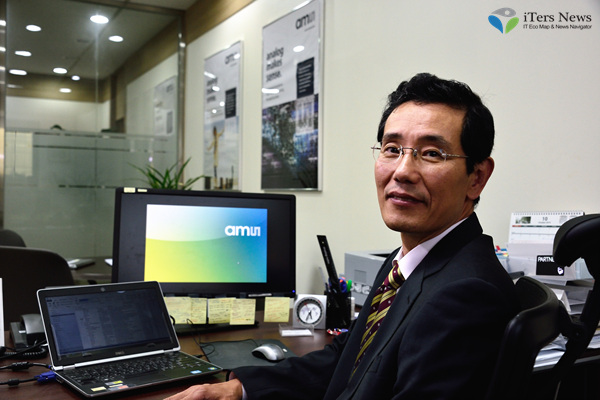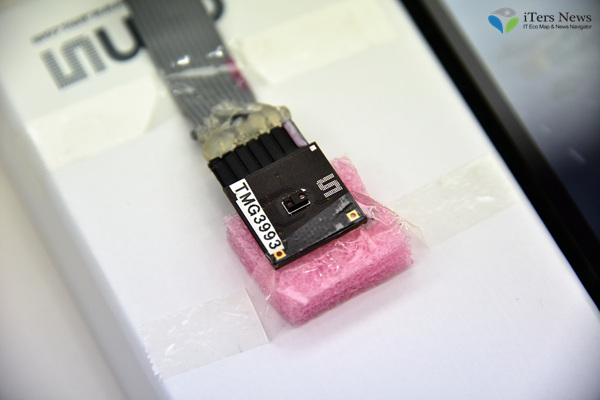(iTers News) - Sensor chip is one of key building block technologies for IoT, or Internet of Things infrastructure, enabling devices in the smart sensor grid to interact with the ambient environment to help users adjust themselves for changes in temperature, humidity, or atmosphere.
But, it is also an indispensible ingredient of human to machine user interface or UI technologies, allowing people to interact with devices to control them with a motion of gesture or a command of voice.
True enough, sensors are everywhere today, revolutionizing the way that devices interact with the real world. Coming awash in a wealth of sensors, devices get smart enough to feel, see, and understand it as if they were human.
Accordingly, their applications are rapidly expanding going beyond the conventional terrain into yet untapped areas like automobiles, robotics, wearable devices, smart phones and medical equipment.
That’s where the forte of sensor chip maker ams AG zeros in on. The Austria-based chipmaker of sensor solutions and analog ICs , power management ICs, wireless ICs and ASICs sees great market potentials in the growing ubiquity of sensor chips. Its sensor chip portfolio is wide and deep ranging from IR, or infrared-based gesture sensors, optical sensors, position sensors to gas and bio sensors.
Road ahead
In an interview, JD Lee, country manager with ams Korea Co., Ltd. said, “Sensors are the mechanical equivalent of human sensory organs. We are working on bio sensor technologies that can emulate human’s five senses, aiming to integrate several sensor functions into single chip solutions. The first generation one chip solution we expect to be available before the end of next year.”

That’s an add-on to its broad range of sensor chip portfolio. The chip maker is world’s No.1 supplier of intelligent optical sensors like color sensors, proximity sensors, LED lighting sensors, and gesture sensors, making up more than 30% of that market
The color sensor is a sort of optical sensor that detects color temperature to make color corrections to optimize display quality.
What’s more, ams AG has already secured design wins for its IR-based gesture sensor chips from several global smart phone makers, including world’s top smartphone maker Samsung Electronics.
The IR-based gesture sensor is widely being used for smart phones, allowing users to flip through screens with a swipe of fingers or hands, or move up to down or left to right moving objects on phone screen. But also, the swipe of hands up and down and left to the right can allow users to turn on or off the Internet, or enable them to change lanes in the car racing game.
The application doesn’t stop there. Once designed in the smart phone, the gesture sensor can complement a touch screen sensor allowing users to receive or deny incomes calls just with a swipe of fingers or hands without touching a screen. Especially it is useful when users’ hands are dirty, gloved.
Human to machine interface
Bio sensor chips are the next big application market that ams AG is closely eyeing, as a growing number of wearable devices like smart watches are implementing them for healthcare applications. The chipmaker is exploring optical technologies including IR lighting and UV (ultra violet) in its bio-sensor chip developments aiming to measure human blood pressure, blood glucose, or skin temperature.

Its magnetic positioning sensors are also being widely used in automotive power steering, a gear transmission shift box, and a pedaling pad. The chip maker is also supplying ASIC chip solutions for automotive safety and lighting.
“Automobile markets are not hot growth area like smart phone, but lucrative, steadily growing market where there are long-term and stable growth opportunities ahead. Although ams AG has yet to carve out big places there, we are well poised to tap into the new growth opportunities,” JD Lee stressed.
ANC, or active noise cancellation chip is another sure-bet. It is being widely used in earphone and headphone sets, as it can give crystal clear voice quality by cancelling ambient noises.
ams AG has one more breakthrough technology up his sleeve. That’s NFC, or near field communications. ams AG had snatched a big design win for its solution from Apple Inc, supplying it for Apple iPhone 6. A NFC antenna power booster chip, it is part of Apple iPhone 6’s NFC-based mobile wallet system.
NFC booster in Apple iPhone 6
According to ams, the booster is its own home-grown indigenous breakthrough technology that can magnify the performance of an HF tag by up to 100 times. It has enormous market potential for a wide range of small form factor devices like wearable watches, as it can allow system designers to design in smaller footprint antenna by boosting the performance of an antenna by up to 100 times using synchronized transmitted signals.
“That’ a sort of communications technology. As IoT networks are being built around a combination of a sensor grid network and a short-range communication technology network like ZigBee, NFC, and RF-ID, the booster chip will well combine with our sensor chip portfolio to carve out niches in the IoT as well as industrial and automotive markets, working as the human to machine interface hub,” JD Lee said.
As Asia is the world’s largest manufacturing hub for smart mobile devices and cars, Asian regions account for close to 60% of ams’ annual revenue. Korea is also emerging as prospective market. Looking forward, JD Lee aims for the Korean operation to make up more than 15% of its revenues in the coming years. The chipmaker is operating an 8-inch wafer fabrication facility in Austria.
차세대 먹거리 찾아 자동차 웨어러블 시장 출사표
적외선 광학 센서 및 전원관리 반도체 전문업체 ams AG가 새로운 성장동력을 발굴하기 위해 사물인터넷 통신 (IoT: Internet of Things)과 자동차 시장을 적극 공략할 계획이다.
ams AG 코리아 이종덕 지사장은 인터뷰에서 “센서 칩은 사물인터넷 통신의 한 축을 이루는 센서 망(Sensor Grid)의 핵심 기술로서 성장 가능성이 아주 높은 응용분야일 뿐만 아니라 자동차 로봇 의료기기 등에서 인간과 기계를 이어주는 Human to Machine interface 기술로 빠르게 자리를 잡아가고 있다 “고 말하며 “스마트워치(Smart Watch), 스마트 헬스 트랙 (Smart Health Tracker) 등 새로운 웨어러블 기기(Wearable) 의 등장으로 응용 분야가 무궁무진하다”고 강조했다.
오스트리아 본사를 둔 ams는 적외선 광학(IR: Infrared)기술을 이용한 제스처 센서인 호버링(Hovering)으로 스마트폰 및 게임기업체들에게는 아주 잘 알려진 반도체 회사이다.
호버링이란 빛을 이용하여 손이나 물체의 움직임을 탐지하는 기술로 사용자들이 손가락이나 손을 사용하지 않고 스마트폰이나 게임기의 터치스크린에 나타나는 각종 기능이나 앱을 작동시킬 수 있도록 해주는 터치리스 유저인터페이스의 일종이다.
삼성전자의 갤럭시 5에 탑재된 것으로 알려진 IR 기반의 호버링 제스처 센서는 현재 전세계 19개 스마트폰 제조업체 중 15개 업체가 채택하여 사용하고 있을 정도로 각광을 받고 있는 UI (User Interface)기술이다.
중국의 스마트폰 업체 ZTE도 ams의 제스처 센서 Nubia Z5S 와 Z7 스마트폰 두 모델의 UI 기술로 채택하여 사용하고 있다. IR 제스처 센서는 이 밖에도 냉장고 전면의 컨트롤 보드 등 가전 제품과 스마트워치 등 웨어러블 기기에도 광범위하게 사용되고 있다.
IR기반의 제스처 센서의 폭발적인 인기에 힘입어 ams는 지난해 세계 지능형 광학센서 시장의 30% 이상을 점유했다 (IHS2013 시장조사 참조). 이는 2위 업체의 시장 점유율을 2배나 뛰어넘는 실적으로 지능형 광학센서 시장에서 독보적 지위를 누리고 있음을 알 수 있다.
손가락 하나로 척척...
차세대 성장동력으로 ams사가 눈 여겨 보고 있는 시장은 화학 및 자동차 용 센서시장이다. 이를 위해 ams는 지난 6월 4일 화학 가스 센서 전문 업체 어플라이드 센서(Applied Sensor)를 인수하여 의료 로봇 등 산업용 센서 시장에 진출하기 위한 제품 포트폴리오를 완성했다.
자동차 시장도 ams가 전략적으로 노리고 있는 차세대 먹거리 시장이다. ams는 조향대 (Steering Wheel), 자동차 좌석, 타이어 등에 사용되는 마그네틱 위치센서 (Magnetic Positioning Sensor)를 앞세워 자동차 시장을 적극 공략할 계획이다.
자동차, 산업용 로봇 의료기기 시장 등은 웨어러블 기기와 함께 향후 IoT 기술의 핵심 응용분야가 될 시장으로 새로운 UI 기술인 광학센서 가스센서 등 각종 최첨단 센서기술이 활용될 가능성이 무궁무진하다.
스마트폰을 대체할 포스트 스마트폰 시대의 성장 엔진으로 떠 오르고 있는 웨어러블기기 시장도 매력적이다. 웨어러블 시장을 공략하기 위해 ams가 내세우는 비장의 무기는 BoostedNFC 솔루션이다.
Mobile Wallet, 즉, 전자지갑 시대를 겨냥해 개발한 이 제품은 애플이 최근 출시한 아이폰6에 탑재되어 초단거리 비접촉식 무선통신기술인 NFC(Near Field Communications)칩과 함께 모바일 결제 시스템인 애플 페이(Apple Pay)의 핵심 기술을 구성하고 있다.
전자지갑 시대를 연다
BoostedNFC는 NFC태그 칩이 리더기에 보내는 전파 신호를 증폭하여 리더기의 수신감도를 높여주는 기술이다. 즉 모든 무선 통신에서 전파에 데이터를 실어 보내기 위해서는 신호 변조, 즉 modulation 과정을 거쳐야 하는데 이때 NFC태그와 리더기의 무선 전파 신호를 동기화하여 리더기가 태그에서 오는 신호를 자신의 신호로 착각하도록 하여 리더기의 수신 감도를 높이는 기술이다.
ams에 따르면 BoostedNFC는 태그의 기능을 100배 이상 증강하는 효과가 있다고 한다. NFC를 이용한 모바일 결제 시스템에서 가장 중요한 것은 태그와 리더기가 서로를 알아보고 인증하는 절차인데 Boosted NFC기술을 이용하면 NFC태그 칩과 리더기 사이에 신호를 좀 더 안정적으로 전달할 수 있기 때문에 인증오류가 생길 확률이 낮아진다.
애플의 아이폰 6의 애플 페이 시스템은 NFC 태그 칩에 BoostedNFC 칩이 함께 붙어 기능하는 구조로 이루어진다. 부스트 칩에는 암호화 작업을 수행하는 시큐어 매니지먼트가 내장되어 있어서 NFC 기능과 전자지갑의 보안기능을 둘 다 수행할 수 있다.
BosstedNFC기술을 이용하면 또한 기존 무선 안테나 수신감도를 700배 이상 증가할 수 있다. 안테나의 길이는 주파수에 비례하기 때문에 이 기술을 이용하면 안테나의 크기를 크게 줄일 수 있어 작은 form factor의 웨어러블 기기에는 안성맞춤이다.
ams는 이 밖에도 Active Noise Cancelation이라는 소음 제어 음향기술을 보유하고 있다. 이 기술을 스마트폰의 이어폰이나 헤드셋에 적용하면 주변의 소음을 깨끗이 필터링하기 때문에 원음에 가까운 소리를 들을 수 있는 장점이 있다.
ams는 오스트리아에 8인치 웨이퍼 팹을 운영하고 있는 30여 년의 역사를 자랑하는 IDM 종합반도체회사로 최첨단 아날로그 센서 솔루션 설계 및 제조에 집중하고 있다. 지능형 조명센서, RFID/NFC 화학 센서, 위치센서는 물론, 초 저전력 전원관리 칩, 주문형 반도체인 ASIC도 디자인 생산하고 있다. 1,500명 이상의 직원이 20개국에 걸쳐 근무하고 전세계에 9곳의 디자인 센터를 운영하고 있다. 지난해 2013년 회계연도 매출은 5억 2백만 달러이며 센서 제품의 판매 호조에 힘입어 올해는 30% 이상 매출이 신장할 것으로 기대하고 있다


